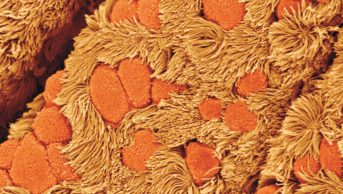
Dr Tony Brian / Science Photo Library
This content was published in 2014. We do not recommend that you take any clinical decisions based on this information without first ensuring you have checked the latest guidance.
Kate Jones is a 50-year-old teacher. She has been using salbutamol and fluticasone/salmeterol inhalers and taking oral modified-release theophylline (400mg twice a day) to manage her emphysema, a form of chronic obstructive pulmonary disease (COPD), for several years. She has been a heavy smoker for most of her life and has recently decided to quit. She asks your advice about whether she can start nicotine replacement therapy (NRT) while taking theophylline.
Theophylline is a xanthine derivative used in the treatment of asthma and stable COPD to relax the bronchial smooth muscle. It has a narrow therapeutic index; a serum theophylline concentration of 10–20mg/L is required in the majority of patients, although some may find lower theophylline levels to be sufficient to control their symptoms.
Small increases in serum concentrations can result in toxicity, particularly in patients with a level of more than 20mg/L. Patients may experience serious symptoms of toxicity, such as convulsions and arrhythmias, before symptoms like nausea and vomiting appear.
For oral theophylline, the British National Formulary[1] states that serum concentrations should be measured five days after starting therapy, and at least three days after each dose adjustment. Once a maintenance dose is established, theophylline levels can be monitored every 6–12 months[2].
It is important to maintain patients on the same brand of modified-release theophylline throughout their treatment. This avoids unnecessary changes to their serum theophylline concentrations because of possible variations in absorption rates between different brands.
Symptoms of theophylline toxicity
- Nausea
- Vomiting
- Gastric irritation
- Diarrhoea
- Palpitations
- Tachycardia
- Arrhythmias
- Headache
- Central nervous system stimulation
- Insomnia
- Convulsions
Theophylline metabolism
The drug is metabolised in the liver by cytochrome P450 isoenzymes, principally CYP1A2, to demethylated and hydroxylated products. Many drugs interact with theophylline by inhibiting or potentiating its metabolism by CYP1A2 (see ’Commonlyused drugs that interact with theophylline’). Induction of CYP1A2 results in a more rapid clearance of theophylline, which leads to reduced, and most likely sub-therapeutic, serum theophylline concentrations.
| Benzodiazepines | Theophylline appears to antagonise the sedative and anxiolytic effects of benzodiazepines |
| H2-receptor antagonists | Theophylline concentrations are increased by cimetidine, however, famotidine, nizatidine, and ranitidine do not appear to interact |
| Ciprofloxacin | Ciprofloxacin causes large increases in theophylline concentrations |
| Erythromycin | Theophylline clearance can be reduced by erythromycin, and erythromycin exposure might be reduced by theophylline |
| Levothyroxine | Thyroid dysfunction can modestly affect theophylline requirements; isolated cases of theophylline toxicity have been reported in patients being treated for hypothyroidism |
| Methotrexate | Methotrexate reduces theophylline clearance, and theophylline might reduce methotrexate-induced neurotoxicity; there is the possibility that it may also reduce methotrexate efficacy |
| Phenytoin | Phenytoin increases the clearance of theophylline, and theophylline might also reduce serum concentrations |
The metabolism of theophylline can be affected by other factors such as smoking and possibly sex. A higher theophylline clearance has been reported in healthy premenopausal women compared with healthy men; this difference was thought to be caused by sex-related factors in hepatic metabolism3[3][4]. However, another study found sex did not appear to affect theophylline clearance[5].
Genetic differences in CYP1A2 function can also affect the metabolism of theophylline. Currently it is not known to what extent these differences may affect metabolism, or the proportion of patients who are affected.
Stopping smoking
Smokers taking theophylline generally tend to require higher doses than non-smokers as tobacco smoke contains polycyclic hydrocarbons, which induce CYP1A2. Smoking cessation will therefore result in an increase in serum theophylline concentrations, and possibly toxicity, if the dose is not reduced.
If Kate Jones wishes to quit smoking she will need to be monitored for changes in her serum theophylline concentrations; a dose reduction of up to a third might be needed after just one week[6]. Kate Jones should be advised to discuss her desire to stop smoking, and the effects this will have on her theophylline treatment, with her GP before setting a date to quit smoking.
Because it is the polycyclic hydrocarbons in tobacco smoke — not the nicotine — that increase theophylline clearance, NRT will not affect Mrs Jones’s theophylline concentrations and it can be prescribed or sold to her.
Bupropion or varenicline can also be prescribed to help Kate Jones stop smoking. However, bupropion has a small dose-related risk of seizures. The manufacturers of bupropion state that the concurrent use of theophylline might lower the convulsive threshold, further increasing patients’ risk of seizures, and recommend a maximum bupropion dose of 150mg daily[7].
Fluconazole
A month after starting her attmept to quit smoking, Kate Jones returns and asks to buy an oral antifungal over the counter for symptoms of vaginal thrush.
You consider selling Kate fluconazole over the counter.
A crossover study in five healthy subjects found that fluconazole 100mg given every 12 hours for seven doses caused a 16% decrease in the clearance of a single 300mg oral dose of aminophylline, which was not statistically significant[8]. In nine people who took fluconazole 400mg once a day for 10 days, the clearance of a single 6mg/kg oral dose of theophylline was reduced by 13%[9]. Another study in ten healthy subjects found that fluconazole 100mg once a day for one week had no effect on the serum concentrations of theophylline 150mg twice a day[10]. However, an isolated case report describes an unexplained increase in theophylline concentrations in a patient taking fluconazole.[11]
Based on these studies, fluconazole does not appear to interact with theophylline to a clinically relevant extent. However, it is possible that occasionally changes in theophylline concentrations might occur in patients taking fluconazole. Therefore an interaction should be considered if any unexplained reduction in theophylline efficacy or an increase in theophylline-related adverse effects (e.g., headache, nausea or tremor) occur, and theophylline concentrations should be monitored accordingly.
In the case of Mrs Jones, a clinically relevant interaction does not seem likely from a single 150mg dose of oral fluconazole, and she can be sold the capsule with appropriate counselling.
St John’s wort
A few months later Kate Jones returns to the pharmacy for advice. She has been feeling rather low since the sudden death of her mother and is anxious about the upcoming funeral. She asks if she can take St John’s wort, which she hopes should not be a problem as it is a “natural” medicine. Most clinically significant interactions reported with St John’s wort are mediated by CYP3A412[12], of which St John’s wort is a moderate inducer. Theophylline is not known to be metabolised by this isoenzyme.
One isolated case report described a large decrease in serum theophylline concentrations for a person taking St John’s wort 300mg once a day with theophylline 300mg twice a day[13]. However, no pharmacokinetic interaction was noted in a study of 12 healthy people taking St John’s wort 300mg three times a day with a single 400mg oral dose of theophylline[14], and mechanistic studies suggest a modest interaction at most[15].
In 2000, the Committee on Safety of Medicines recommended that patients taking theophylline should avoid St John’s wort, and that St John’s wort should be stopped and the theophylline dose monitored and adjusted if necessary for patients already taking the combination[17][16]. However, this guidance was issued before the pharmacokinetic study that suggests that an interaction is generally unlikely was conducted.
Until further evidence is available to confirm the absence of an interaction, the possibility of an interaction should be considered if theophylline adverse effects develop.
You should advise Mrs Jones that, although an interaction would not normally be expected, if she does choose to take St John’s wort she should be vigilant for any increase in adverse effects from theophylline. You should advise her to consult her GP if her low mood persists.
SSRIs
A few weeks later, you receive a telephone call from Kate Jones’s GP, who explains he has decided to start a selective serotonin reuptake inhibitor (SSRI) in conjunction with cognitive behavioural therapy (CBT).
He would usually opt for fluoxetine or or citalopram, but since she is taking theophylline he would like to know which of the two options would be most suitable.
A study in 13 healthy subjects taking oral theophylline with citalopram[18], and a study in eight healthy subjects taking intravenous aminophylline with fluoxetine[19], did not show any changes in the pharmacokinetics of theophylline. Citalopram and fluoxetine have been shown only weakly to inhibit CYP1A2 in vitro. Consequently, neither drug is expected to interact with theophylline.
However, there might be a risk of QT-interval prolongation with the concurrent use of theophylline and citalopram, because citalopram has been seen to cause a dose-dependent increase in the QTcF interval. Although the manufacturers of fluoxetine state that there are post-marketing reports of QT-interval prolongation, no studies have been carried out with QT-prolonging drugs[20]. Older patients, particularly women, and those with heart disease and some metabolic disturbance are predisposed to QT prolongation, which can lead to torsades de pointes arrhythmia.
Although xanthenes themselves do not prolong the QT interval, in excess doses they can decrease serum potassium concentrations, which can potentiate the QT-prolonging effect of citalopram.
In this case, you can advise Mrs Jones’s GP that she could take either SSRI with theophylline; however, he should monitor her potassium levels if he chooses to prescribe citalopram.
References
- Joint Formulary Committee. British National Formulary. 67th ed. London: BMJ Group and Pharmaceutical Press, 2014.
- Sweetman SC. Martindale: The complete drug reference. 38th ed. London: Pharmaceutical Press. 2011.
- Nafziger AN & Bertino JS. Sex-related differences in theophylline pharmacokinetics. Eur J Clin Pharmacol:1989;37:97–100.
- Jennings TS, Nafziger AN, Davidson L. et al. Gender differences in hepatic induction and inhibition of theophylline pharmacokinetics and metabolism. J Lab Clin Med:1993;122:208–216.
- Powell JR, Thiercelin JF, Vozeh S et al. The influence of cigarette smoking and sex on theophylline disposition. Am Rev Respir Dis:1977;116:17–23.
- Lee BL, Benowitz NL & Jacob P. Cigarette abstinence, nicotine gum, and theophylline disposition. Ann Intern Med:1987;106:553–5.
- Zyban (Bupropion hydrochloride). GlaxoSmithKline. UK Summary of Product Characteristics. November 2013.
- Konishi H, Morita K & Yamaji A. Effect of fluconazole on theophylline disposition in humans. Eur J Clin Pharmacol:1994;46:309–12.
- Foisy MM, Nix D, Middleton E et al. The effects of single dose fluconazole (SD FLU) versus multiple dose fluconazole (MD FLU) on the pharmacokinetics (PK) of theophylline (THL) in young healthy volunteers. Intersci Conf Antimicrob Agents Chemother:1995;39:7.
- Feil RA, Rindone JP, Morrill GB et al. Effect of low-dose fluconazole on theophylline serum concentrations in healthy volunteers. J Pharm Technol 1995;11:267–269.
- Tett S, Carey D & Lee H-S. Drug interactions with fluconazole. Med J Aust 1992;156:365.
- Wang Z, Gorski JC, Hamman MA et al. The effects of St John’s wort (Hypericum perforatum) on human cytochrome P450 activity. Clin Pharmacol Ther 2001;70:317–326.
- Morimoto T, Kotegawa T, Tsutsumi K et al. Effect of St John’s wort on the pharmacokinetics of theophylline in healthy volunteers. J Clin Pharmacol 2004;44:95–110.
- Nebel A, Schneider BJ, Baker RK et al. Potential metabolic interaction between St John’s wort and theophylline. Ann Pharmacother. 1999;33:502.
- Gurley BJ, Gardner SF, Hubbard MA et al. Cytochrome P450 phenotypic ratios for predicting herb-drug interactions in humans. Clin Pharmacol Ther 2002;72:276–287.
- Committee on Safety of Medicines (UK). Message from Professor A Breckenridge (Chairman of CSM) and Fact Sheet for Health Care Professionals, 29th February 2000.
- Committee on Safety of Medicines/Medicines Control Agency. Reminder: St John’s wort (Hypericum perforatum) interactions. Current Problems 2000;26:6–7.
- Møller SE, Larsen F, Pitsiu M et al. Effect of citalopram on plasma levels of oral theophylline. Clin Ther 2000;22:1494–1501.
- Mauro VF, Mauro LS, Klions HA. Effect of single dose fluoxetine on aminophylline pharmacokinetics. Pharmacotherapy 1994;4:367.
- Prozac (Fluoxetine hydrochloride). Eli Lily and Company Ltd. UK Summary of Product Characteristics, March 2013.
You might also be interested in…

Helping respiratory patients breathe easy

Asthma therapies get personal
